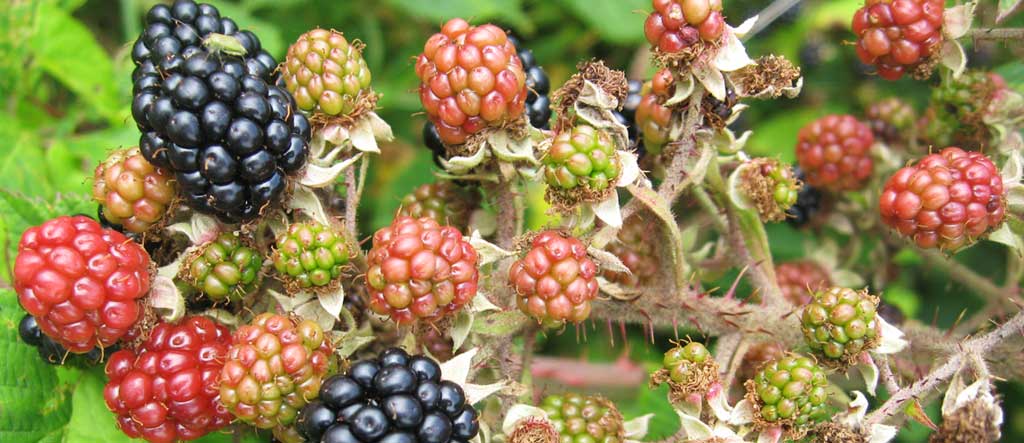Rubus fruticosus, A.K.A.: Bramble
If you regularly walk past blackberry bushes, when the berries are ripe, without picking any you are definitely missing out on one of Nature’s great bounties. Blackberries are an excellent source of Vitamins C and K and manganese, they are rich in bioflavonoids and contain both soluble and insoluble dietary fibre.
Blackberries are valued for their anticancer properties due to their high content of antioxidants, which are known to destroy the free radicals that harm cells and can lead to cancer. Antioxidants help to protect and strengthen the immune system. They are especially helpful when it comes to reducing the risk of esophageal, cervical, and breast cancer.¹
Blackberries have one of the highest levels of antioxidants of all fruits.
Blackberries contain a host of phytochemicals such as catechins, quercetin, rutin, and anthocyanins. These key nutrients work together to protect the body from cancer and cardiovascular disease, improve skin tone, and improve memory and clarity of thought. They also possess antibacterial and anti-inflammatory properties.²
Blackberry fruit contains gallic acid, malic and citric acids, which were found to be more effective than chlorine in the prevention and removal of Bacillus subtilis biofilms on food contact surfaces.³
Harvest blackberry from late summer through early autumn.
The majority of us can readily identify blackberry when the fruit ripens in late summer. It is common to see green berries alongside fully ripe ones, and even see late white and pink flowers. The berries can often be around through to October.
To date, more than 80 micro-species of Bramble have been identified in Ireland.4 The differences are so subtle that most of us would never notice.
Blackberry Harvesting Tips

- Colour: Pick blackberries when they are black, rather than green, red, or purple.
- Size: Pluck plump berries that come easily away when you pick them.
- Look for a white core, or heel, where the berry comes away from the stem, this indicates the berry has not been spoiled.
- Taste: Blackberries should taste sweet and be firm, but not hard, to the touch.
- The sugar content of the berries varies through out the day. Late morning, after the sun has been on them for a while is generally regarded as the best time, or late afternoon to early evening as the day cools.
- Always pick on a dry day, or if it’s been raining allow a couple of dry days before going out to harvest.
- You have until the first frost to harvest blackberries, however don’t leave it so late as pickings will not be as sweet.
Blackberry Cordial
Blackberries are rich in Vitamin C as well as being anti-microbial and astringent, which explains their traditional use as a remedy for diarrhoea and whooping cough. This traditional Irish blackberry cordial can be enjoyed as a hot or cold drink.
Ingredients:
- ½ gallon of blackberries
- 1 cup of water
Directions:
- Put the blackberries and water into a large saucepan and place on low heat.
- Stir frequently until the fruit is a soft pulp, then remove from heat and allow to cool.
- Sieve the blackberries through a muslin lined colander or fine sieve. The juice needs to be well strained so that the juice is free of seeds and pulp.
- Bottle and refrigerate.
To Serve: Dilute 2 tablespoons with hot or cold water. Season with cloves and lemon according to your taste.
Blackberry Oxymel
Add a teaspoon to hot water if you feel a cold coming on, or enjoy as a night-time drink.
Ingredients:
- 500 gm of blackberries – washed and allowed to dry
- Apple cider vinegar
- Honey
Directions:
- Put the blackberries in a mason jar and cover with apple cider vinegar.
- Leave for 2 – 3 days, then mash the fruit with a potato masher or fork.
- Strain the juice into a measuring jug.
- Add half the volume of honey and transfer all to a saucepan.
- Heat until it comes to a boil. Let boil for 5 minutes.
- Bottle or freeze
Blackberry Vinegar
Ingredients as above, but minus the honey. Cover the berries with apple cider vinegar as above but leave for 3 to 5 days, then strain off and bottle.
Freeze berries for use in smoothies or make jams for a taste of summer in the winter months ahead.
References
(1) Verma, Rameshwar et al. “Rubus Fruticosus (blackberry) Use as an Herbal Medicine.” Pharmacognosy Reviews 8.16 (2014): 101–104. PMC. Web. 23 Aug. 2018.
(2) Grieve M. A Modern Herbal. Blackberry. Online article. Available at: https://botanical.com/botanical/mgmh/b/blaber49.html (Accessed 23/08/2018)
(3) Use of organic acids for prevention and removal of Bacillus subtilis biofilms on food contact surfaces. Online article. Available at: https://www.ncbi.nlm.nih.gov/pubmed/26912168 (Accessed 23/08/2018)
(4) Ireland has more than 80 bramble microspecies. Online article. Availabl at: https://www.wexfordpeople.ie/lifestyle/ireland-has-more-than-80-bramble-microspecies-34988996.html (Accessed 23/08/2018)
